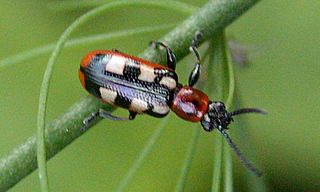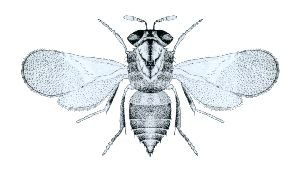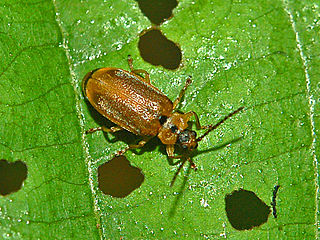
The monarch butterfly or simply monarch is a milkweed butterfly in the family Nymphalidae. Other common names depending on region include milkweed, common tiger, wanderer, and black veined brown. It may be the most familiar North American butterfly, and is considered an iconic pollinator species. Its wings feature an easily recognizable black, orange, and white pattern, with a wingspan of 8.9–10.2 cm(3 1⁄2–4 in) A Müllerian mimic, the viceroy butterfly is similar in color and pattern, but is markedly smaller and has an extra black stripe across each hindwing.

The Colorado potato beetle, also known as the Colorado beetle, the ten-striped spearman, the ten-lined potato beetle or the potato bug, is a major pest of potato crops. It is approximately 10 millimetres (0.39 in) long, with a bright yellow/orange body and five bold brown stripes along the length of each of its elytra. Native to America, it spread rapidly in potato crops across America and then Europe from 1859 onwards.

The common asparagus beetle is an important pest of asparagus crops both in Europe and in North America. Asparagus is its only food plant. The beetle is 6.0 mm to 9.5 mm long and slightly elongated. It is metallic blue-black in color with cream or yellow spots on its red-bordered elytra. The larvae are fat gray grubs with dark heads.

The tansy beetle is a species of leaf beetle. It measures 7.7–10.5 mm in length and has a characteristic bright metallic green colouration. The common name derives from the tansy plant on which they often feed as both larvae and adults. In addition to the nominotypical subspecies, which repeats the specific name, C. graminis graminis, there are five further distinct subspecies of tansy beetle, which, collectively, have a Palearctic distribution, although in the majority of countries where it is found the species is declining. In the United Kingdom it is designated as 'Nationally Rare' and this localised population, centred on York, North Yorkshire, has been the subject of much recent research.

The scarlet lily beetle, red lily beetle, or lily leaf beetle, is a leaf beetle that eats the leaves, stem, buds, and flowers, of lilies, fritillaries and other members of the family Liliaceae. It lays its eggs most often on Lilium and Fritillaria species. In the absence of Lilium and Fritillaria species, there are fewer eggs laid and the survival rate of eggs and larvae is reduced. It is now a pest in most temperate climates where lilies are cultivated.

Asclepias syriaca, commonly called common milkweed, butterfly flower, silkweed, silky swallow-wort, and Virginia silkweed, is a species of flowering plant. It is in the genus Asclepias, the milkweeds. This species is native to southern Canada and of much of the conterminous eastern U.S., east of the Rocky Mountains, excluding the drier parts of the prairies. It grows in sandy soils and other kinds of soils in sunny areas. It was one of the earliest North American species described in Jacques-Philippe Cornut's 1635 work Canadensium Plantarum Historia. The specific name was reused by Linnaeus due to Cornut's confusion with a species from Asia Minor.

Danaus chrysippus, also known as the plain tiger or African queen, is a medium-sized butterfly widespread in Asia, Australia and Africa. It belongs to the Danainae subfamily of the brush-footed butterfly family Nymphalidae. Danainae primarily consume plants in the genus Asclepias, more commonly called milkweed. Milkweed contains toxic compounds, cardenolides, which are often consumed and stored by many butterflies. Because of their emetic properties, the plain tiger is unpalatable to most predators. As a result, the species' coloration is widely mimicked by other species of butterflies. The plain tiger inhabits a wide variety of habitats, although it is less likely to thrive in jungle-like conditions and is most often found in drier, wide-open areas.

Chrysochus cobaltinus, the cobalt milkweed beetle or blue milkweed beetle, is a member of the diverse family leaf beetles (Chrysomelidae). It occurs in the Western United States and British Columbia.

Charidotella sexpunctata, the golden tortoise beetle, is a species of beetle in the leaf beetle family, Chrysomelidae. It is native to the Americas.

Xanthogaleruca luteola, commonly known as the elm-leaf beetle, is an invasive beetle pest species in the family Chrysomelidae.

The hemlock moth, also known as the defoliating hemlock moth or poison hemlock moth, is a nocturnal moth species of the family Depressariidae. Of Palaearctic origin, it was first found in North America in 1973 when it was accidentally introduced. The moth is now widespread throughout the northern half of the United States, southern Canada, northern Europe, and, more recently, New Zealand. The larval form grows to around 10 mm, while the adults wingspan is between 17 mm and 19 mm.

Asterocampa celtis, the hackberry emperor, is a North American butterfly that belongs to the brushfooted butterfly family, Nymphalidae. It gets its name from the hackberry tree upon which it lays its eggs. The hackberry tree is the only host plant for A. celtis and is the food source for larvae.

Galeruca tanaceti is a species of leaf beetle, described by Linnaeus in 1758.

Aphelinus mali is a parasitoid wasp that exploits the woolly apple aphid, a pest of apple trees. It is native to the northeastern United States but has been introduced to other parts of the world as a biological pest control agent.

Galerucella is a genus of leaf beetles in the family Chrysomelidae described by George Robert Crotch in 1873. It is widely distributed but absent in the Neotropics.Some species feed on waterlilies and are used as biocontrol of introduced, invasive waterlilies. Galerucella tenella feed on strawberry plants.

The fecal shield is a structure formed by the larvae of many species of beetles in the leaf beetle family, Chrysomelidae. It is composed of the frass of the insect and often its exuviae, or bits of shed exoskeleton. The beetle may carry the shield on its back or wield it upon its posterior end. The main function of the fecal shield is defense against predators. Other terms for the fecal shield noted in the literature include "larval clothing", "kotanhang", "faecal mask", "faecal pad", and "exuvio-faecal annex".

Gratiana boliviana is a species of beetle in the leaf beetle family, Chrysomelidae. Its common name is tropical soda apple leaf beetle. It is native to South America, where its distribution includes Argentina, Brazil, and Paraguay. It specializes on tropical soda apple, an invasive plant species. It has been released as an agent of biological pest control against the weedy plant in Florida and other parts of the United States.
Zygogramma exclamationis, commonly known as the sunflower beetle, is a species of leaf beetle belonging to the family Zygogramma. It is regarded as a pest of sunflower crops in North America.

Chelymorpha is a genus of tortoise beetles and hispines in the family Chrysomelidae. There are more than 70 described species in Chelymorpha.

Fidia viticida, the grape rootworm, is a species of leaf beetle. Grape rootworms are found in eastern North America, south to Mexico, and have been recently reported as far north as Quebec. Adults are typically 4.9 to 7.0 mm in length. They are colored mahogany brown, and are covered with white to straw-yellow hairs.




















